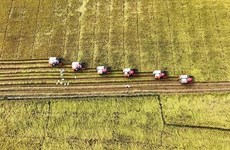Urgent solutions needed to boost coffee’s sector
Vietnam is the world’s second largest coffee exporter, behind only Brazil. However its coffee export value is much lower than other nations’ as the country only exports raw coffee. Besides, shortcomings in preservation and the lack of specified processed products have hindered the sector’s growth.
This year, Lam Ha key coffee area in the Central Highlands province of Lam Dong enjoyed a bumper crop after lean years due to unfavorable weather condition and lack of drying machines.
Do Thi Hien, a coffee grower from Nam Ban town, Lam Ha district, Lam Dong province said that previously, they did not know how to dry the coffee bean and if it rained, all the beans would get mouldy. Now they dry the whole coffee bean because the beans have two peel layers, they will no longer go mouldy.
Local authorities have acknowledged that with an output of more than 450 tonnes of raw coffee, which is equivalent to more than 1.5 million tones of fresh coffee, the current number of processing facilities in the region has not met coffee manufacturers’ demand, especially during peak season.
Deputy Chairman People’s Committee of Lam Dong province, Nguyen Van Yen told our reporter that during harvesting period, 450 tonnes of raw coffee need to be dried within a month, but it’s very wasteful if coffee growers use the kilns for only 1 month and leave them idle in the 11 remaining months
Lam Dong is not the sole locality to face such difficulties. Lack of preserving equipment after harvesting while weather condition has become more severe has hindered the coffee sector’s growth.
Chairman of Vietnam Coffee- Cocoa Association, Luon Van Tu shared that currently, Vietnam has 640,000 households growing coffee. There are also have many dealers who don’t really pay much attention to coffee quality. Furthermore, unfavorable weather condition and lack of drying equipment have caused several difficulties for coffee growers.
Meanwhile, during the processing step, the country’s sector has puzzled in finding solutions to increase the ratio of processed coffee.
Minister of Agriculture and Rural Development, Nguyen Xuan Cuong reckoned that if Vietnam's coffee sector reorganize production in a more scientific way, which is based on comprehensive application of advanced technology from processing steps to trade organisation, the sector can surely can double the sector’s value by 2030.
Obviously, there is still much to be done to lift the country’s sector position on the world’s coffee value chain, staring from harvesting step and preliminary processing./.













